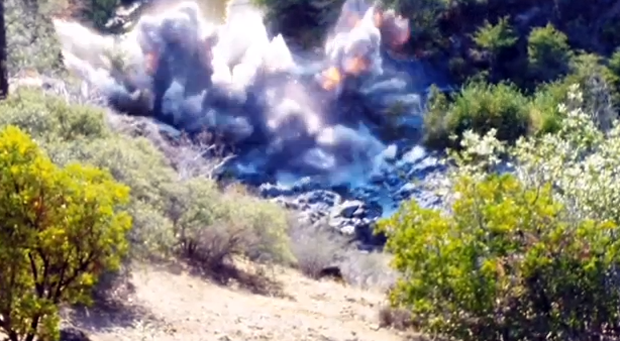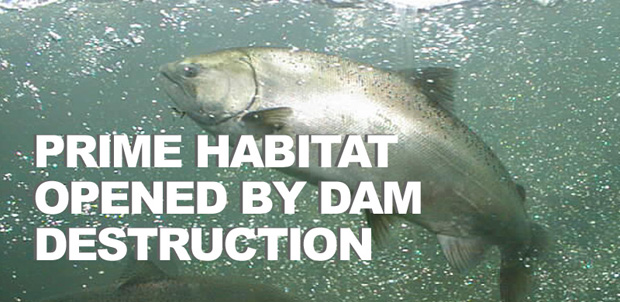Removal of diversion dam improves habitat access for migrating fish in California’s Tehama County
Spring 2015
[dropcap]W[/dropcap]ith a pyrotechnics show lasting less than a minute, federal and state officials helped a landowner in California’s Central Valley open five miles of fish habitat on a tributary to the Sacramento River. U.S. Fish and Wildlife Service (USFWS), California Department of Fish and Wildlife (CDFW), NOAA Fisheries, and a private landowner removed Hammer Diversion Dam this past September—a long-standing barrier 30 miles west of Red Bluff, California that blocked protected Central Valley Chinook salmon and steelhead from reaching prime spawning and rearing habitat upstream.
The 80 year-old diversion dam on the South Fork of Cottonwood Creek was built in the 1930s to provide water and hydropower to a private residence. CDFW constructed a fish ladder in the 1970s to help fish bypass the barrier, but over the years the ladder fell into disrepair. Working with the landowner, the agencies identified alternative sources of water and power for the residence, and in exchange received permission to demolish the dam.
The removal of Hammer Dam will allow adult spring-run Chinook to access upstream areas with favorable temperatures for holding. This may contribute to restoring a small population of these fish in South Fork Cottonwood Creek. The removal will also allow steelhead unimpeded upstream and downstream passage year-round, which is expected to decrease potential stress, injury, and mortality associated with downstream migration, and potentially increase steelhead populations in the area.
The demolition furthers several habitat restoration and endangered species recovery initiatives in the Central Valley by removing barriers to upstream habitat needed for salmon and steelhead to spawn successfully. These initiatives include the Central Valley Salmon and Steelhead Recovery Plan; the Central Valley Project Improvement Act’s Anadromous Fish Restoration Program’s Final Restoration Plan; and the multi-agency Ecosystem Restoration Program Conservation Strategy for the Sacramento-San Joaquin Delta, Sacramento Valley, and San Joaquin Valley Regions.
According to Naseem Aston, NOAA Fisheries’ lead biologist for the project, “Removing this antiquated dam is an excellent example of the kind of high priority actions we can take for recovering salmon and steelhead in the Central Valley. There are many other opportunities like this, but removing this dam is an excellent start.”
Prior to dam demolition, resident fish and other aquatic species near the site were relocated to ensure they were not impacted while the structure was removed. Environmental monitoring, erosion control, and planting of riparian vegetation were also conducted as resource protection measures. Although the dam is now gone, a water diversion remains so a new fish screen was installed to keep from entraining fish in the diversion—ensuring they can safely pass to and from the newly accessible upstream habitat.
Biologists expect winter rains to disperse any gravel remaining behind the dam after demolition, leaving passage open for salmon and steelhead. Steelhead are expected to begin moving upstream of the dam site through early summer, and small numbers of spring-run Chinook could enter the watershed in March or April.
Habitat monitoring will occur over the next three to five years, both down- and upstream of the site. Researchers will be assessing temperature, turbidity, and other aspects of the riparian zone to make sure species are establishing in the newly accessible habitat.
Learn More bout salmon & steelhead in the Central Valley . . .









